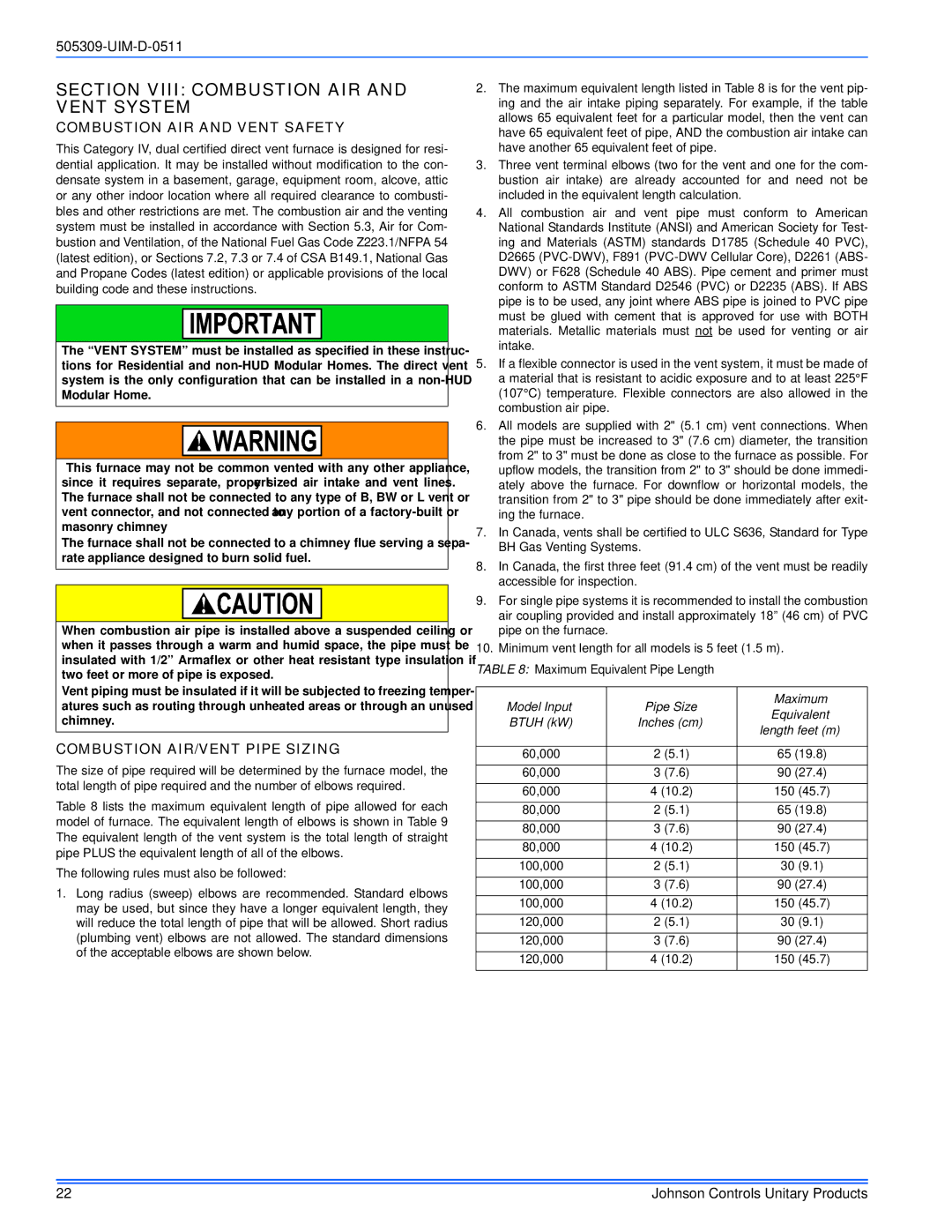SECTION VIII: COMBUSTION AIR AND VENT SYSTEM
COMBUSTION AIR AND VENT SAFETY
This Category IV, dual certified direct vent furnace is designed for resi- dential application. It may be installed without modification to the con- densate system in a basement, garage, equipment room, alcove, attic or any other indoor location where all required clearance to combusti- bles and other restrictions are met. The combustion air and the venting system must be installed in accordance with Section 5.3, Air for Com- bustion and Ventilation, of the National Fuel Gas Code Z223.1/NFPA 54 (latest edition), or Sections 7.2, 7.3 or 7.4 of CSA B149.1, National Gas and Propane Codes (latest edition) or applicable provisions of the local building code and these instructions.
The “VENT SYSTEM” must be installed as specified in these instruc- tions for Residential and non-HUD Modular Homes. The direct vent system is the only configuration that can be installed in a non-HUD Modular Home.
This furnace may not be common vented with any other appliance, since it requires separate, properly sized air intake and vent lines. The furnace shall not be connected to any type of B, BW or L vent or vent connector, and not connected to any portion of a factory-built or masonry chimney
The furnace shall not be connected to a chimney flue serving a sepa- rate appliance designed to burn solid fuel.
When combustion air pipe is installed above a suspended ceiling or when it passes through a warm and humid space, the pipe must be insulated with 1/2” Armaflex or other heat resistant type insulation if two feet or more of pipe is exposed.
Vent piping must be insulated if it will be subjected to freezing temper- atures such as routing through unheated areas or through an unused chimney.
COMBUSTION AIR/VENT PIPE SIZING
The size of pipe required will be determined by the furnace model, the total length of pipe required and the number of elbows required.
Table 8 lists the maximum equivalent length of pipe allowed for each model of furnace. The equivalent length of elbows is shown in Table 9 The equivalent length of the vent system is the total length of straight pipe PLUS the equivalent length of all of the elbows.
The following rules must also be followed:
1.Long radius (sweep) elbows are recommended. Standard elbows may be used, but since they have a longer equivalent length, they will reduce the total length of pipe that will be allowed. Short radius (plumbing vent) elbows are not allowed. The standard dimensions of the acceptable elbows are shown below.
2.The maximum equivalent length listed in Table 8 is for the vent pip- ing and the air intake piping separately. For example, if the table allows 65 equivalent feet for a particular model, then the vent can have 65 equivalent feet of pipe, AND the combustion air intake can have another 65 equivalent feet of pipe.
3.Three vent terminal elbows (two for the vent and one for the com- bustion air intake) are already accounted for and need not be included in the equivalent length calculation.
4.All combustion air and vent pipe must conform to American National Standards Institute (ANSI) and American Society for Test- ing and Materials (ASTM) standards D1785 (Schedule 40 PVC), D2665 (PVC-DWV), F891 (PVC-DWV Cellular Core), D2261 (ABS- DWV) or F628 (Schedule 40 ABS). Pipe cement and primer must conform to ASTM Standard D2546 (PVC) or D2235 (ABS). If ABS pipe is to be used, any joint where ABS pipe is joined to PVC pipe must be glued with cement that is approved for use with BOTH materials. Metallic materials must not be used for venting or air intake.
5.If a flexible connector is used in the vent system, it must be made of a material that is resistant to acidic exposure and to at least 225°F (107°C) temperature. Flexible connectors are also allowed in the combustion air pipe.
6.All models are supplied with 2" (5.1 cm) vent connections. When the pipe must be increased to 3" (7.6 cm) diameter, the transition from 2" to 3" must be done as close to the furnace as possible. For upflow models, the transition from 2" to 3" should be done immedi- ately above the furnace. For downflow or horizontal models, the transition from 2" to 3" pipe should be done immediately after exit- ing the furnace.
7.In Canada, vents shall be certified to ULC S636, Standard for Type BH Gas Venting Systems.
8.In Canada, the first three feet (91.4 cm) of the vent must be readily accessible for inspection.
9.For single pipe systems it is recommended to install the combustion air coupling provided and install approximately 18” (46 cm) of PVC pipe on the furnace.
10.Minimum vent length for all models is 5 feet (1.5 m).
TABLE 8: Maximum Equivalent Pipe Length
| Model Input | Pipe Size | Maximum |
| Equivalent |
| BTUH (kW) | Inches (cm) |
| length feet (m) |
| | |
| | | |
| 60,000 | 2 (5.1) | 65 (19.8) |
| 60,000 | 3 (7.6) | 90 (27.4) |
| 60,000 | 4 (10.2) | 150 | (45.7) |
| 80,000 | 2 (5.1) | 65 (19.8) |
| 80,000 | 3 (7.6) | 90 (27.4) |
| 80,000 | 4 (10.2) | 150 | (45.7) |
| 100,000 | 2 (5.1) | 30 | (9.1) |
| 100,000 | 3 (7.6) | 90 (27.4) |
| 100,000 | 4 (10.2) | 150 | (45.7) |
| 120,000 | 2 (5.1) | 30 | (9.1) |
| 120,000 | 3 (7.6) | 90 (27.4) |
| 120,000 | 4 (10.2) | 150 | (45.7) |

